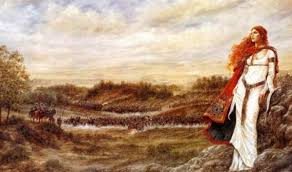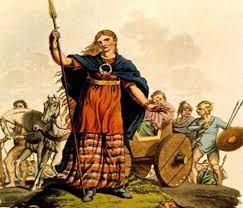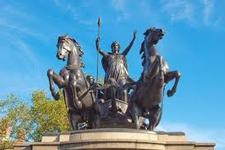The Roman settlement of Londinium was less than 20 years old in AD 61 but had already been established as the commercial centre of Roman Britain, with opulent buildings and fabulously wealthy residents. It had not always been easy for the Romans to pacify the wild native Britons but Londinium, as well as other settlements across the south of modern day England, was an example of Roman culture being successfully established on an island that the empire had only recently gained a foothold on. However, disturbing stories were beginning to circulate of a Celtic warrior, a warrior Queen no less, who was whipping up resentment among her people and uniting the previously divided Celtic tribes against their common Roman enemy. The fearsome native army had already bulldozed their way through another successful town, Camulodunum, leaving a trail of death and devastation in their wake. They now had their sights set on Londinium.
The warrior Queen at the head of what could arguably be labelled the first British army was named Boudicca (she is also known as Boadicea), and she desired nothing less than the total eradication of the new Roman presence in her homeland. Fierce, tall and with a long flock of fiery red hair, she struck paralysing fear into Roman hearts for at least a year, before she and her people ultimately succumbed to the remorseless expansion of the most powerful empire in Ancient Europe.
Background
Boudicca had not always been so vehemently opposed to Roman occupation. According to Sarah Pruitt she was born in around AD 30 to an elite family in Camulodunum (now Colchester), and was married at the around the age of 18 to Prasutagas, King of the Celtic Iceni tribe who were based in modern day East Anglia. Prasutagas had been allowed to remain as King of his people on the condition that he became an ally of the Roman empire, which had established itself in southern Britain in AD 43. He and Boudicca had two daughters together, and the couple were able to bring them up in relative peace given the tribe’s harmonious relationship with the new Roman occupiers.
Boudicca’s tolerance of Roman rule was not to last. When Prasutagas died in AD 60, he left most of his private wealth to Boudicca and their daughters whilst also gifting some of it to the Roman Emperor Nero, in the hope that his family and his people would be left unmolested by Rome. The Iceni people believed that Boudicca would remain as their Queen and that they would be able to maintain their previous relationship with the Romans, however their lands were immediately confiscated, and leading tribesman had their wealth plundered. When Boudicca tried to rectify this, she was flogged for her insubordination and forced to watch as her daughters were raped by Roman soldiers. The Roman historian Tacitus suggests that at this moment she swore an oath of vengeance on Rome, and while this is probably just a piece of creative exaggeration on his part it is no doubt reflective of Boudicca’s truly vengeful feelings. Having lost her lands and endured humiliation at the hands of the Rome, Boudicca had nothing left to lose in her pursuit of revenge.
Rebellion against Rome
Part of the reason the Romans had found southern Britain relatively easy to conquer is the fact that the native Celtic people were divided into tribes which had a long history of conflict with one another. Indeed, when the Romans first arrived some of the Celtic tribes – including the Iceni – had been keen to enlist them as allies as they engaged in their local hostilities, not realising the irreversible influence they had gifted to the new invaders. Yet by AD 60, nearly twenty years into the Roman occupation, the ground was fertile for a unification of the Celtic peoples against their common Roman enemy. All that was needed was a leader willing to drag the warring tribes together, and Boudicca was ready to fill this void.
While the Roman governor of Britain, Suetonius Paulinus, was attempting to conquer Wales, Boudicca approached her neighbouring tribes and implored them to put their differences aside and rebel against Rome. The tribes, including the Trinovantes and the Catuvellauni, readily agreed and followed Boudicca as she took up arms. Like other Celtic women Boudicca was a trained warrior and took to her new role easily, leading her massive army – over 100,000 warriors according to some historians – as they destroyed a handful of Roman military posts. Boudica set her sights on Camulodunum, not only because it was where she was born, but because it had been taken from her new Trinovantes allies and developed into a quintessential Roman town. It was also home to many retired Roman veterans who had done more than their part to ensure the conquering of the Celtic people.
Boudicca leads her army
With the bulk of the Roman forces away in Wales, the only Roman army near enough to face her was based in Lindum Colonia (modern day Lincoln). Upon seeing the approaching Celtic army, the townspeople begged for help from there and from Londinium. The Lindum Colonia legion, led by Quintus Petillius Cerialis, and a paltry 200 men sent from Londinium raced to Camulodunum but despite their huge disadvantage in numbers did not seriously believe that Boudicca posed much of a threat. The Romans had a dismissive view of the Celts, seeing them as barbarians who were incapable of organising a serious military force, and to make them even more complacent this Celtic army was led by a woman and was populated by significant number of warrior women. This was standard for the Britons, but for the Romans this was a laughable prospect and they strolled onto the field of battle just outside Camulodunum fully confident of suppressing the irritating upstarts. Their confidence was entirely misplaced. The Roman army was routed, with only Cerialis and his cavalry managing to escape. Boudicca, standing triumphant on her famous chariot, was unchallenged as she led her people into the town of her birth to burn it to the ground. The Britons were merciless. It is hard to imagine the fear the Roman townspeople must have felt as the marauding natives, covered in paint and hollering in a strange and coarse language, indiscriminately slaughtered their way through the town. There is a particularly tragic story of men, women and children huddling in the temple of Claudius, hoping and praying that a relief army would reach them before the Celts burst into the building. Their prayers were not answered, and the temple was burnt to the ground with everyone inside. This was not just a military victory, but a systematic massacre. Yet Boudicca would no doubt have felt entirely justified in what she and her army had done – after all, it was the Romans who were the invaders, and the Romans who had inflicted such torment on her, her daughters and her people. She was unstoppable in her mission for vengeance, and now set her sights of the biggest prize in Roman Britain – Londinium.
When Governor Paulinus learnt of what had transpired he marched his army back south and reached Londinium before Boudicca. He contemplated giving battle to the Celts outside the town but, having considered the manner of the defeat at Camulodunum and with Boudicca having now earnt his respect, he decided to preserve his army and abandoned the town to its fate. The natives were unopposed as they poured into the town, wreaking havoc in much the same way as they had done at Camulodunum. No Roman or Roman sympathiser was spared, and the distinctly Roman stone buildings which had been erected in the previous few years were razed to the ground. Again, one cannot overstate the fear that this Celtic army, led by a fierce warrior Queen, caused the Roman population. Boudicca contradicted everything the Romans thought a woman ought to be. She was a brutal, skilled warrior and a natural leader. She was also physically imposing, with several sources noting her height and her unruly locks of red hair. She and her wild native army were an absolutely terrifying prospect for the Roman occupiers. Indeed, it is even claimed by some sources that the Emperor Nero himself considered withdrawing all Roman forces from Britain when he heard about Boudicca.
After decimating Londinium Boudicca marched her army, which was picking up new Celtic recruits along the way, to Verulamium (modern day St. Alban’s) and gave it the exact same treatment. Tacitus claims that over 70,000 Romans were killed in her rampage and while one must remember that, as a Roman himself, Tacitus may well have exaggerated this figure, there is agreement among modern historians that the number of Romans killed was in the tens of thousands. Governor Paulinus knew that he could not avoid the inevitable, and that his only options were to give battle to Boudicca now, or flee the island altogether. Being a brutal warrior himself, he decided to give battle.
The exact location of this final battle is not known, with most historians estimating a site anywhere between modern day Northamptonshire and London. However, one does not need to know the exact location of the battle to understand the how important it was to both sides. Paulinus understood that this was potentially the last stand of the Roman army in Britain, that he would either be victorious, or he would lose control over the island as well as his life. Boudicca understood that this was her one huge chance to wipe out the entire Roman army in Britain, to vanquish them from her homeland and avenge herself, her husband, her daughters and her people. With her daughters standing by her side on her chariot, she must have felt confident as she surveyed the Roman army which was vastly outnumbered by her own. She almost certainly felt confident of another rout. But the Roman empire was not built by armies superior in number to their enemies. Rather, it was built by armies superior in guile, organisation and military intelligence. The battle was indeed a rout, but not in the way Boudicca had expected.
Her army faced the Romans, screaming and hollering as they always did, taunting them and daring them to launch an attack. But the battle-hardened Romans merely stood in stony silence, confident that the position they had taken up and their superior organisation would be enough to give them victory. When the Celts finally attacked, roared on and led by their Queen, it was in a chaotic, unruly charge. This had been enough to overwhelm the small Roman forces they had faced before, but it was no match for Paulinus’ professional machine. The Romans held their lines against an enemy that prized individual bravery over military tactics, and methodically ground out their inevitable victory. Most of the Celtic army was massacred. The Romans were here to stay.
As for Boudicca herself, accounts vary but all agree that she died after the battle, either from the shock of her loss or, more likely, from poisoning herself so that she was not taken prisoner by the victorious Romans. She would have been about 30 years old. So ended the life of a remarkable woman who had recovered from unimaginable torture, inspired and united her people and taken on the most powerful empire in the world. Though she was ultimately unsuccessful in her rebellion, she had – for a while at least – shaken that empire to its very core.
Legacy
In the cold light of day, Boudicca’s rebellion had very little impact on the tide of history. The Romans continued their conquest of Britain and did not leave until the empire collapsed 350 years after she died. Her Celtic people were pushed out of most of modern-day England and into Cornwall, Wales, Scotland and Ireland. Yet she is still remembered and revered as a hero in Britain. Modern Britain is littered with monuments in her honour, not least one just outside the Houses of Parliament. Though her achievement of rocking the confidence of the Roman empire for a short time inspires pride in modern Britons, she is revered more for what she represents. She was a proud rebel, an underdog against a formidable enemy, a woman who led her people valiantly but was beaten by a superior enemy. History has countless examples of heroic failures, and Boudicca is Britain’s most cherished one.
Boudicca's statue outside the Houses of Parliament.
Acknowledgements
The Ministry of History is not an academic source. Our pieces are written by writers who have been studying history for years and are well versed in and influenced by countless other writers and works. For this article specifically our sources have included:
'Boudicca', article published by bbc.co.uk
'Who was Boudicca?' article by Sarah Pruitt, published by history.com (2016)
Images:
Image one - ancient-origins.net
Image two - ancientpages.com
Image three - livescience.com


